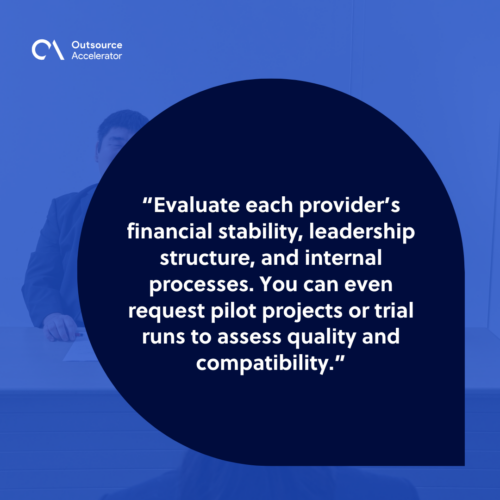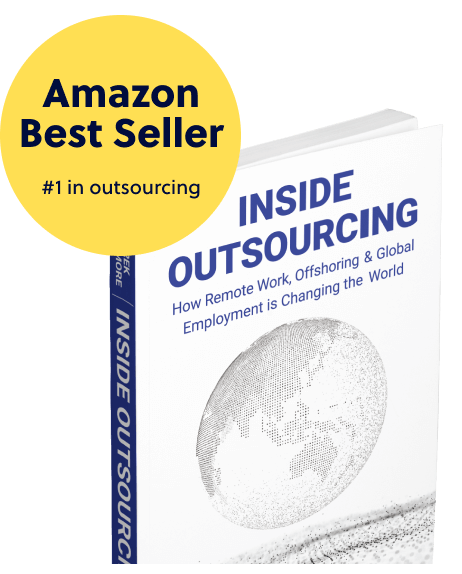How to manage outsourcing risks in 7 steps

Outsourcing enables companies to save on resources, scale faster, and tap into global talent. But while it can drive efficiency and growth, outsourcing also comes with challenges that, if ignored, can undermine your business goals.
From communication gaps to data security concerns, understanding and managing outsourcing risks is key to building strong, long-term partnerships.
Fortunately, working with trusted outsourcing partners like Hugo can significantly reduce these risks—helping you build high-performing teams with confidence.
Why companies outsource
Businesses outsource to access specialized expertise, streamline operations, and reduce costs—without compromising quality. When managed effectively, outsourcing allows organizations to operate more efficiently and stay competitive in fast-changing markets.
Some of the most common reasons why companies outsource include:
- Cost efficiency: Outsourcing reduces expenses tied to hiring, training, and maintaining in-house teams by up to 70%. This is especially valuable in the age of remote work, as more businesses realize that they can find equally qualified talent at lower labor costs.
- Access to global expertise: Companies gain access to a worldwide pool of professionals with specialized skills, advanced education, and industry-specific experience. This global reach allows businesses to fill hard-to-find skill gaps locally.
- Scalability and flexibility: Outsourcing enables businesses to scale operations up or down quickly in response to demand. Unlike in-house hiring, outsourcing offers the agility to adapt to changing project requirements.
- Focus on core activities: Delegating non-core tasks frees internal teams to focus on high-value initiatives such as strategy and product development. Resources saved through outsourcing can be redirected toward boosting profitability.
- Improved time-to-market: With distributed teams working across time zones, companies can maintain round-the-clock productivity and bring products or services to market faster.

Outsourcing risks and how to deal with them
Outsourcing has been proven effective time and time again, but it’s not without pitfalls. Here are the main outsourcing risks and practical ways to address them:
Outsourcing risk #1: Miscommunication and cultural differences
Differences in time zones, language, and workplace culture can lead to misunderstandings or missed deadlines. Even small communication gaps can escalate into larger operational issues.
Solution: Establish clear communication protocols and standardized reporting formats. Use collaboration tools like monday.com or Slack to keep everyone aligned.
Additionally, it’s important to schedule regular check-ins and create overlapping working hours to maintain real-time coordination.
Outsourcing risk #2: Quality and performance issues
When expectations aren’t clearly defined, outsourced work may fall short of your company’s quality standards. This can affect customer satisfaction and overall project success.
Solution: Define clear service-level agreements and key performance indicators from the very beginning. To ensure alignment, conduct regular performance reviews and feedback sessions. This helps all parties (outsourcers, remote staff, and staffing providers) stay on track.
Outsourcing risk #3: Data privacy and security risks
Transferring sensitive company or customer data to external teams can expose your business to data breaches, leaks, or compliance violations.
Solution: Choose partners who strictly follow recognized data protection standards such as GDPR or ISO 27001. Require non-disclosure agreements, use encrypted communication channels, and regularly audit security practices to ensure compliance.
Outsourcing risk #4: Hidden or unexpected costs
Even with a clear contract, unexpected costs can arise from project delays, additional revisions, or scope changes. These expenses can quickly erode the cost benefits of outsourcing.
Solution: Demand transparent pricing and a detailed breakdown of deliverables. Include clauses in your contract to manage revisions, set expectations for additional work, and prevent scope creep.
3 additional steps to prevent outsourcing risks
To manage outsourcing risks effectively, businesses need more than quick fixes—they also need a proactive strategy.
These steps focus on building a strong foundation before and during your outsourcing engagement to minimize potential problems.
1. Conduct thorough due diligence
Evaluate each provider’s financial stability, leadership structure, and internal processes. You can even request pilot projects or trial runs to assess quality and compatibility.
This ensures you’re partnering with a reliable provider who can scale with your business.
2. Develop a robust onboarding and knowledge transfer plan
Start your partnership strong with a detailed onboarding process. Document workflows, share brand guidelines, and assign a point person to facilitate training.
A structured knowledge transfer minimizes confusion and accelerates ramp-up time.
3. Build flexibility into contracts and operations
Markets shift, and so do business priorities. Design contracts that allow adjustments for scope, timelines, and pricing as conditions evolve.
Maintaining operational flexibility ensures your outsourcing strategy remains resilient, even during disruptions or changing demands.

Minimize outsourcing risks with Hugo
Hugo is more than just a service provider; it’s “your partner in progress and your catalyst for growth.”
Partnering with Hugo minimizes outsourcing risks by combining world-class talent, proven systems, and deep collaboration. Every partnership is built on transparency, stability, and shared success—so businesses don’t just outsource tasks, they gain a trusted extension of their team.
Specializing in digital and AI operations, omnichannel customer support, and trust and safety solutions for some of the world’s leading tech and media companies, Hugo helps clients scale efficiently while maintaining the highest standards of quality and security.
Through the HugoSphere℠, it builds lasting relationships—most clients work with the same dedicated team for over 3.5 years, ensuring consistency, trust, and long-term alignment.
Visit www.hugoinc.com to start building your high-performing, low-risk outsourcing team today.







 Independent
Independent




